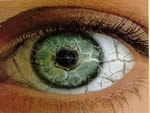
ACS Eye Specialist Centre
95G & 97G Jalan TKS 1,
Taman Kajang Sentral,
43000 Kajang,
Selangor, Malaysia.
Tel: 03-82116078
Waze or Google Map
Dry Eyes
What is Dry Eye syndrome?
Dry eye syndrome is one of the most common problems treated by eye doctors. It is usually caused by a problem with the quality of the tear film that lubricates the eyes.
Tears are comprised of three layers. The mucus layer coats the cornea, the eye’s clear outer window, forming a foundation so the tear film can adhere to the eye. The middle aqueous layer provides moisture and supplies oxygen and other important nutrients to the cornea. This layer is made of 98 percent water along with small amounts of salt, proteins and other compounds. The outer lipid layer is an oily film that seals the tear film on the eye and helps to prevent evaporation.
Tears are formed in several glands around the eye. The water layer is produced in the lacrimal gland, located under the upper eyelid. Several smaller glands in the lids make the oil and mucus layers. With each blink, the eyelids spread the tears over the eye. Excess tears flow into two tiny drainage ducts in the corner of the eye by the nose. These ducts lead to tiny canals that connect to the nasal passage. The connection between the tear ducts and the nasal passage is the reason that crying causes a runny nose.
In addition to lubricating the eye, tears are also produced as a reflex response to outside stimulus such as an injury or emotion. However, reflex tears do little to soothe a dry eye, which is why someone with watery eyes may still complain of irritation.
What causes dry eyes?
Dry eye syndrome has many causes. One of the most common reasons for dryness is simply the normal aging process. As we grow older, our bodies produce less oil – 60% less at age 65 then at age 18. This is more pronounced in women, who tend to have drier skin then men. The oil deficiency also affects the tear film. Without as much oil to seal the watery layer, the tear film evaporates much faster, leaving dry areas on the cornea.
Many other factors, such as hot, dry or windy climates, high altitudes, air-conditioning and cigarette smoke also cause dry eyes. Many people also find their eyes become irritated when reading or working on a computer. Stopping periodically to rest and blink keeps the eyes more comfortable.
Contact lens wearers may also suffer from dryness because the contacts absorb the tear film, causing proteins to form on the surface of the lens. Certain medications, thyroid conditions, vitamin A deficiency, and diseases such as Parkinson’s and Sjogren’s can also cause dryness. Women frequently experience problems with dry eyes as they enter menopause because of hormonal changes.What are the symptoms?
• Itching
• Burning
• Irritation
• Redness
• Blurred vision that improves with blinking
• Excessive tearing
• Increased discomfort after periods of reading, watching TV, or working on a computer
How is this condition detected and diagnosed?
There are several methods to test for dry eyes. The doctor will first determine the underlying cause by measuring the production, evaporation rate and quality of the tear film. Special drops that highlight problems that would be otherwise invisible are particularly helpful to diagnose the presence and extent of the dryness.
What is the treatment?
When it comes to treating dry eyes, everyone’s needs are a little different. Many find relief simply from using artificial tears on a regular basis. Some of these products are watery and alleviate the symptoms temporarily; others are thicker and adhere to the eye longer. Preservative-free tears are recommended because they are the most soothing and have fewer additives that could potentially irritate. Avoid products that whiten the eyes – they don’t have adequate lubricating qualities and often make the problem worse. There are newer lubricating drugs such as those with sodium hyaluronate. These adhere to the surface longer and then to be more expensive than conventional artificial tears.
Closing the opening of the tear drain in the eyelid with special inserts called punctal plugs is another option. This works like closing a sink drain with a stopper. These special plugs trap the tears on the eye, keeping it moist. This may be done on a temporary basis with a dissolvable collagen plug, or permanently with a silicone plug.
There are also simple lifestyle changes that can significantly improve irritation from dry eyes. For example, drinking eight to ten glasses of water each day keeps the body hydrated and flushes impurities. Make a conscious effort to blink frequently – especially when reading or watching television. Avoid rubbing the eyes. This only worsens the irritation.
What are the complications of untreated dry eyes?
Treating dry eye problems is important not only for comfort, but also for the health of the cornea.Some of the serious complications that can occur include corneal ulcers, infection, scarring and visual loss.